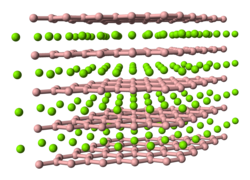Preparation
NbB2 can be synthesized by stoichiometric reaction between constituent elements, in this case Nb and B. This reaction provides for precise stoichiometric control of the materials. [2] Reduction of Nb2O5 (or NbO2) to niobium diboride can also be achieved via metallothermic reduction. Inexpensive precursor materials are used and reacted according to the reaction below:
Nb2O5 + 2 B2O3 + 11 Mg → 2 NbB2 + 11 MgO
Mg is used as a reactant in order to allow for acid leaching of unwanted oxide products. Stoichiometric excesses of Mg and B2O3 are often required during metallothermic reductions in order to consume all available niobium oxide.
Borothermal reduction of NbO2 with elemental boron via solid‐state reaction was proposed by Jha and coworker to obtain nanorods (40 × 800 nm2), [3]
A variation of the borothermal reduction in molten salt was proposed by Ran and co‐worker using Nb2O5 with elemental boron to produce nanocrystals (61 nm). [4]
Nanocrystals of NbB2 were successfully synthesized by Zoli's reaction, a reduction of Nb2O5 with NaBH4 using a molar ratio M:B of 1:4 at 700 °C for 30 min under argon flow. [5]
Nb2O5 + 13/2 NaBH4 → 2 NbB2 + 4Na(g,l) + 5/2 NaBO2 + 13 H2(g)
This page is based on this
Wikipedia article Text is available under the
CC BY-SA 4.0 license; additional terms may apply.
Images, videos and audio are available under their respective licenses.
